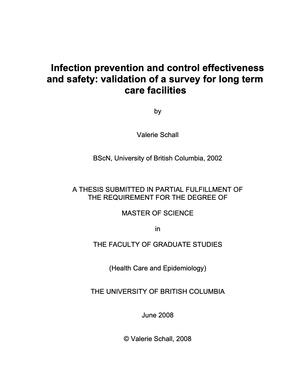Schall, Valerie
Person Preferred Name
Valerie Schall
Affiliation
Related Works
Content type
Digital Document
Abstract
This article describes the methodology used to develop a set of provincial, collaborative, standardized, research-informed guidelines for the prevention and control of seasonal respiratory infections in all healthcare settings. Instead of using a hierarchical model, these guidelines were developed by a group of volunteers from BC’s Pro- vincial Infection Control Network (PICNet). The three-phase methodology included 1) development of a conceptual model for the guidelines, 2) drafting of a ‘skeleton document’, 3) iterative cycle of reviewing and redrafting by a group of PICNet stakeholders and experts from across the province. The success of this project and methodology supports the notion that the collegial nature of the network governance model can be a powerful alternative to the potentially coercive forces of the hierarchical model.
Origin Information
Content type
Digital Document
Abstract
Objectives
First to develop a short survey based on the 2004 Health Canada / Public Health Agency of Canada recommendations for key infection prevention and control (IP&C) structures and processes in long term care facilities and the five Institute of Medicine safety principles published in ‘To Err is Human’ (2000). Then, to establish the validity and feasibility of the survey when used to describe key IP&C structures and processes in LTC facilities within the context of the five safety principles.
Methods
This study was designed using a three-phase methodology. During Phase I, a conceptual model for IP&C was created to develop six structural and process composite indices. The concepts and components covered within each index were developed based on the 2004 Public Health Agency of Canada recommendations for IP&C programs in the LTC setting and a thorough literature review. During the second phase of the study, a group of 7 experts in LTC IP&C were recruited from BC’s Provincial Infection Control Network to validate and further develop the survey and one of these dropped-out at the beginning of the process. The five Safety Principles published in 2000 by the Institute of Medicine were also provided to the experts so they could be used to complement and further develop the concepts covered by the survey. The Delphi methodology was used in this phase of the study so that experts may reach consensus on modifications made to survey questions. The Delphi phase began in April and ended in October 2007; 114 worksheets were sent to experts to support the consensus-reaching process. Consensus was defined as 67% concordance of opinions and experts were given almost unlimited time to respond to worksheets. Once the validity of new survey questions had been established based on expert-group consensus in Phase II, a second draft of the survey was prepared and pilot-tested in Phase III. An invitation letter was sent to a random sample of 20 LTC facilities stratified by facility ownership and governance structure in Fraser Health. The 14 facility Senior Managers who agreed to participate were sent a cover letter and electronically fillable survey. An analysis of the validity of the survey questions and the feasibility of the use of the survey in a larger study was performed, and revisions were made to the survey based on the findings of this analysis.
Conclusions
The three-phase methodology used in this study was very useful and innovative way to further develop and validate the literature-based survey developed in Phase I for IP&C in long term care. In addition, by merging two bodies of knowledge and thought into the process, concepts and components that are not explicitly described in IP&C literature yet were felt to be key in program success, were incorporated into the measurement tool. Using Delphi, the experts expressed a need for IP&C professionals working in LTC to increase their knowledge, understanding and use of safety theory and strategies. They also felt that interdisciplinary work, the development of a culture of safety, and the development clear and simple IP&C systems are key ways in which infections can be prevented and outbreaks quickly controlled. In Phase III, the pilot-study analysis demonstrated the utility, validity and reliability of the survey. In addition, the analysis showed that there is a tendency for facilities to have lower levels of components within the Leadership Index and the ICP Index. If confirmed in a larger study, this would be a major concern as all studies and expert advisory bodies for both IP&C and safety state that a strong, dedicated and knowledgeable leadership is the key to program effectiveness. Further validation of the survey and score calculation methodology should now be performed when the survey is used in a larger study.
Origin Information
Content type
Digital Document
Abstract
Background: Infection prevention and control (IPC) is a critical, although often neglected, part of long- term care (LTC) management. Little is known about what IPC resources are available for LTC and how that impacts patient care and safety.
Methods: One hundred eighty-eight LTC facilities were randomly selected out of all British Columbia facilities and surveyed using a validated survey tool. The tool was used to collect data regarding IPC resources grouped within 6 indices: (1) leadership, (2) infection control professionals (ICP) coverage, (3) policies and procedures, (4) support through partnerships, (5) surveillance, and (6) control activities. All components measured have been identified as key for an effective IPC program. Survey responses were used to calculate scores for IPC programs as a whole and for each of the 6 indices.
Results: Of 188 randomly selected facilities, 86 institutions participated. Facilities were compared by region, funding source, and ICP coverage. Overall, LTC facilities lacked IPC leadership, especially physician support. Having no dedicated ICP was associated with poorer scores on all indices. Only 41% of practicing ICPs had more than 2 years experience, and only 14% were professionally certified. Twenty-two percent of ICPs had additional roles within the institution, and 44% had additional roles outside of the institution. Thirty-five percent of institutions had no IPC dedicated budget.
Discussion: LTC institutionsdwith bed numbers exceeding those in acute caredrepresent an important aspect of health services. These data show that many LTC facilities lack the necessary resources to provide quality infection control programs.
Origin Information
Content type
Digital Document
Abstract
Infection control practitioners (ICPs) and epidemiologists often rely on hospital surveillance results to guide outbreak investigations and to evaluate the effectiveness of infection prevention and control practices. Unfortunately, surveillance results are highly vulnerable to systematic error due to misclassification bias because of the large numbers of health care providers involved in the data collection process, and because of low incidents of infection. Quantitative assessments of misclassification bias can demonstrate its impact on surveillance results
and can help decide whether it is a plausible explanation for surveillance findings. The purpose of this paper is to provide an in-depth analysis of the effect of misclassification bias on data obtained from hospital surveillance.
In order to do this, we used the 2004 Surrey Memorial Hospital Caesarian section outbreak investigation and a fictitious study of ventilator-associated pneumonia (VAP). Statistically insignificant variability between two groups of ICPs was shown to have important clinical significance because of major effects on the incidence of infection calculated. Valid and useful surveillance results were shown to only be obtainable when a single case definition with a high positive predic- tive value and a very high degree of clarity, sensitivity and specificity was consistently used by all health care professionals involved in the surveil- lance data collection process, and when surveillance was targeted to high prevalence infections.
The Centers for Disease Control and Prevention (CDC) defines surveillance as the “ongoing systematic collection, analysis, and interpretation of health data essential to the planning, implementation, and evalua- tion of public health practice closely integrated with the timely dissemination of these data to those who need
to know”. It is the method used by infection control practitioners and public health officers to detect fluc- tuations in dangerous or indicator infections within the hospital envi- ronment and in the community. The data gathered can be used to compare current rates to previous rates within the same environment or population, and to compare with regional, national or international rates. Surveillance findings can therefore be powerful tools for outbreak investigations, to evaluate control measures, for quality improvement and for supporting prac- tice and policy changes at all levels within the health care system.
Nevertheless, the data collected using surveillance are only useful if they are valid and reliable. Statistical methods of analysis often only account for random error and control- lable confounding, and only explain
a small portion of the total error that can affect surveillance results. A large portion of the total error results from the measures used to seek out cases, as well as from the frequency of misclassification of cases and non-cases. The purpose of this paper is to provide an in-depth analysis of the effect of misclassification bias on the data obtained from hospital surveillance. Two surveillance scenarios will be used to illustrate why misclassification may occur and how misclassification bias may affect surveillance findings. Actual data from a recent outbreak
of surgical site infections (SSI) was used for the first scenario, and data for the second senario was derived from literature on ventilator-associated pneumonia (VAP).
Origin Information


